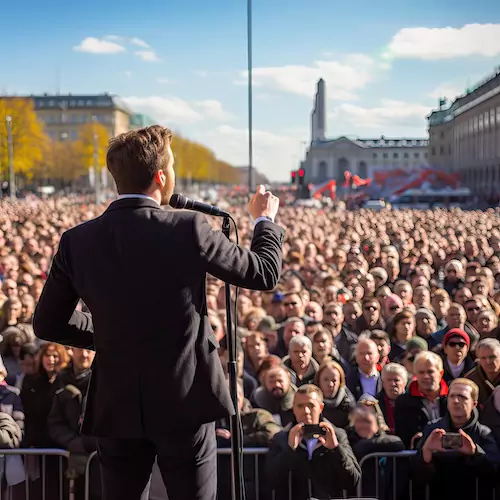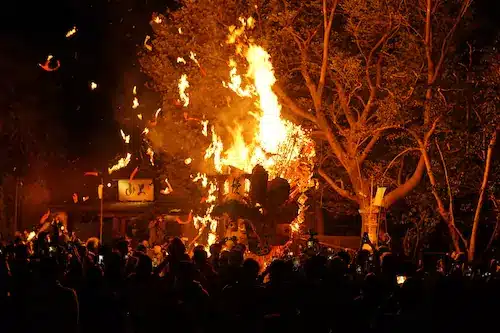Public event planning is not as easy as it is to just go enjoy a public event.
Think about it the last time you were at a large-scale public event. Was it a concert? Or a convention?
Do you remember being mesmerized by it?
You too can create such mesmerizing experiences. This article will lay the blueprint for you.
A. What are public events?
Public events are those gatherings that are open to everyone who wants to attend. They are different from personal events that operate on an invite basis only.

Public events can be designed to entertain, educate, or raise awareness about a cause. While there are many types, some examples of public events include:
- Festivals, for example, Mardi Gras, and National Fried Chicken Festival bring people together
- Concerts such as Coachella
- Parades for a cause or to show community support. Examples include Pride Parades and Thanksgiving Parades
- Exhibitions and fairs can be educational or informative events. They can be called public events as long as anybody who purchases the ticket can get an entry
Now, let’s get into the basics before we tell you how to organize public events. Feel free to skip it if your public event planning basics are already clear. Head to the section after that using the index next to the article.
B. What are the 7 stages of public event planning?
Let’s begin to understand how public event planning actually folds out.

- Conceptualization: Magnificent events don’t just appear out of nowhere. Imagination and creativity are behind all kinds of successful events. Even the monuments you see were just ideas at some point. So, sit with the stakeholders and discuss all the ideas you have in mind
- Research: Understanding your target audience before an event is key. If it’s a concert, you need to know exactly what kind of people would be interested in such an event. The variable factors here are the artist and the kind of fan following they have, the area, etc. You’ll need to ask yourself such questions for other events too. Are you targeting young families with a bouncy castle playground (think demographics)? Do tech enthusiasts crave a VR gaming experience (interests)? Understand your audience’s preferences and how they consume information (social media, local newspapers).
- Budgeting: Public events often operate with tighter budgets than extravagant award shows. Here’s where you get creative! Budgeting is like baking a cake: you need to allocate resources wisely while exploring options. Can you secure sponsorships from local businesses (think bakery partnerships)? Are there free or low-cost public spaces you can utilize (community center instead of a rented hall)? Resourcefulness is key!
- Logistics: The venue selection is like choosing the foundation for your house. It needs to be the perfect fit! Consider accessibility, capacity to accommodate your expected crowd, and amenities offered by the venue. Public parks, libraries, or community centers can be budget-friendly options for public events. Don’t forget to factor in permits required for things like amplified music or food vendors
- Marketing: Imagine your event as a captivating movie trailer. You need a stellar marketing strategy to spread the buzz! Develop a compelling description that highlights the benefits and excitement for attendees. Utilize a mix of online channels like social media posts and event websites, along with offline options like flyers in relevant community spaces and announcements in local newspapers
- Management: The big day has arrived! Think of event execution as the grand opening of your meticulously planned house. To ensure a smooth flow, assemble a team of volunteers or co-organizers to delegate tasks. Create a detailed schedule outlining activity timings, speaker presentations, and entertainment segments. Safety should be a top priority: develop a plan that includes emergency procedures, first aid stations, and crowd control measures
- Evaluation: The event might be over, but your work isn’t done yet! Gathering feedback through surveys or questionnaires is crucial. Understanding what resonated with attendees and identifying areas for improvement will make your future events even better. Share positive outcomes through press releases or social media to amplify the event’s impact. This will also solidify its place in the community calendar
C. How to organize public events?
This section is probably the whole reason why you clicked on this article. So, here’s public event planning processes for you in a nutshell.

- Define the purpose and aim of the event. Is it for entertainment, awareness, or purely profit?
- Figure out your target audience so you can mold your marketing efforts accordingly. This will help you choose the right communication channels later
- Jot down the non-negotiables. For example, if a certain artist MUST perform at your event, that comes in the non-negotiables list. Straighten out your priorities at the earliest
- Create a budget with 15-20% contingency funds that are not included in the initial budget draft. You can allocate maximum funds to the non-negotiables as discussed before and keep it flexible for other things
- Develop cost-saving measures like sponsorships, volunteers, and partnership venues
- Step 4 and 5 must happen simultaneously you can track your expenses and profits
- Finalize the venue that has all the facilities you need. Consider accessibility, capacity, amenities, and permits required. Public parks, community centers, and libraries can be budget-friendly options
- Pick a date and time with broad appeal. Try to avoid conflicts with holidays or major local events
- Define the USP of your event that will be a compelling message to drive event attendance. You need an event description that highlights the benefits and value proposition for attendees
- Utilize a mix of online and offline promotional strategies. Social media, local community newspapers, and flyers in relevant public spaces can spread the word
- Create an event schedule in the days leading up to the event and of course, the day of the event
- Assemble a team of volunteers or co-organizers. Delegate tasks and ensure a seamless event flow
- Develop a safety plan. It must include emergency procedures. first aid, and crowd control measures using authorized entries
- Upon successful execution of the event, don’t just calculate profits. Look at the qualitative success as well. You can do these by getting attendee insights through surveys or questionnaires
- Issue press releases or share social media posts highlighting the success of your event
- Continue to foster the community of attendees so that you can repeat customers
D. Examples of successful public event planning
By dissecting successful public events, we can get valuable insights. These will teach you how to leave a lasting positive impact.
1. How did Burning Man Event become successful?

Burning Man is a week-long public event that is about radical self-expression. Its unique concept is definitely its USP.
With its larger-than-life expression and huge DIY installations, it attracts a huge crowd.
This event is driven by its attendees. Participants actively contribute to the event’s magic. The “mutant vehicles,” large-scale art installations, and themed camps are all created by attendees. This also fosters a sense of community.
Burning Man emphasizes strict environmental responsibility. Participants clean up meticulously after themselves, leaving the desert pristine. This commitment to sustainability sets a powerful example for other public events.
2. Why is Oktoberfest so famous?

It is a 16-day festival that celebrates Bavarian culture with beer, music, and traditional food.
The audience includes beer enthusiasts, tourists, and locals who enjoy tradition.
This event has a history dating back to the early 19th century. This deep cultural significance fuels also adds to its appeal.
The organizers meticulously plan every detail. From ensuring a sufficient beer supply to managing the massive crowds, they do it all. As you can tell, logistics are one of the major reasons behind this event’s success.
Oktoberfest is a significant economic driver for Munich, boosting tourism and revenue for local businesses. This economic benefit ensures continued support for the event.
3. What is the strategy used by Ted Talks?

TED stands for Technology, Entertainment, and Design. TED Talks are a series of short, powerful talks on a wide range of topics presented by leading thinkers.
TED Talks have a global audience. It encompasses anyone curious about the world and seeking inspiration.
They curate presentations around impactful and thought-provoking ideas. This focus on intellectual stimulation keeps audiences engaged and wanting more.
TED Talks are available online for free, making them accessible to a global audience. This widespread reach fuels their virality and amplifies their impact.
4. What makes Comic-Con so popular?

Comic-Con is a massive pop culture convention. It celebrates comics, graphic novels, movies, video games, and TV shows.
The target audience is pop culture enthusiasts, cosplayers (costume players), and industry professionals.
They provide a platform for fans to connect, celebrate their fandoms, and meet creators they admire.
The event offers a variety of activities beyond just booths and panels. Cosplay contests, movie premieres, and gaming tournaments are some of the attractions.
Additionally, high-profile celebrities and industry insiders also come for panels and Q&A sessions. This star power draws in fans and fuels media attention.
E. FAQ
1. What is the meaning of an event open to the public?
A public event is open to all. Anybody who has bought the ticket can enter. Some public events are also free and open to everybody who shows up. These are typically larger gatherings where people come together for various purposes.
2. How do I host a public event?
Hosting a public event is not easy. Effective public event planning requires a lot of skill and experience.
Regardless, you’ll first have to figure out your event’s goal and who you want to attend.
Then, set a budget, and pick a date that works for your audience. Soon after, find a venue that can hold everyone comfortably.
Don’t forget to check with the local authorities for any permits you might need.
Once the groundwork is set, promote your event through social media and other channels.
Finally, organize the details like setup, volunteers, and safety.
With careful planning and execution, your public event can be a success!
F. Join EventTube for free
While we did lay the blueprint for public event planning, we must give you a fair warning.
It will be hectic. You will make mistakes. Success will also follow.
But in the end, you’ll realize that planning public events is such a rewarding experience.
We hope this guide works as a good starting point to make your dreams a reality.
If you found this helpful, you’re bound to love our LinkedIn community. We have thousands of event planners ready to share ideas and collaborate. See you there!






